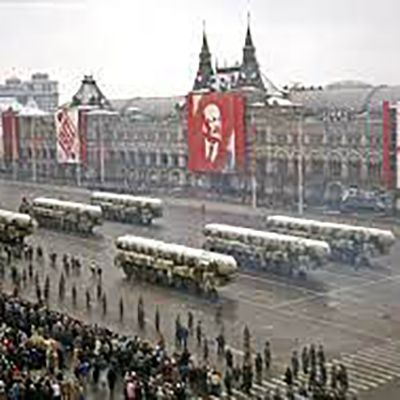Sites
The Union of Soviet Socialist Republics
Written by: Emad Ezatabadi,
Translated by: Hadi Qorbanyar
65 Views
During the Iran–Iraq War, the Union of Soviet Socialist Republics (USSR), commonly referred to as the Soviet Union, provided Iraq with extensive military, advisory, and intelligence support.
With an area of 22,402,200 square kilometers, the Union of Soviet Socialist Republics stretched across Eastern Europe, northern Asia, and the North Pacific Ocean. Its capital and largest city was Moscow. It was a transcontinental Eurasian state, with most of its territory located in Asia, making it the largest country in the world.[1]
In 1972, the Soviet Union signed the Treaty of Friendship with Iraq, constructed the port of Umm al-Qasr, and supplied Baghdad with arms and ammunition. Therefore, Iraq was turned into a strategic base for expanding Soviet influence in the Persian Gulf and the Indian Ocean.[2]
Before Iraq’s invasion of Iran, the USSR had extensive relations with Baghdad and regarded Iraq as a member of the Eastern Bloc.[3] Among the Soviet military aids to Iraq before the war were the delivery of Osa-class missile boats and the enhancement of the country’s naval capabilities.[4]
At the outset of the Iran–Iraq War, the Soviet Union—then Iraq’s largest arms supplier—temporarily halted its weapons shipments to Baghdad.[5] Before this suspension, the two countries had already strengthened their ties through the signing of a fifteen-year Treaty of Friendship and Cooperation in 1972, as well as the decision to nationalize its oil industry and undermine Western influence.[6]
Nevertheless, during the war, the Soviet Union requested its Eastern European allies to meet Iraq’s military needs. Consequently, Russian-made tanks were delivered to Iraq either directly or via Saudi Arabia.[7] Using its Osa-class boats equipped with Styx missiles, Iraq targeted Iranian commercial and oil vessels. However, as a result of Iran’s successful Operation Morvarid in November 1980, Iraq’s capacity to carry out such attacks was effectively neutralized.[8] Shortly thereafter, following a visit by Iraqi officials to Moscow and bilateral discussions, the suspension of arms deliveries was lifted, and the USSR resumed extensive military support to Iraq.[9] The revival of Soviet–Iraqi cooperation was likely driven by the 1972 Treaty of Friendship, Iraq’s opposition to the Camp David Accords, and Moscow’s desire to prove its commitment to supporting its allies. However, Iraq’s repression of domestic communists, its opposition to the Soviet invasion of Afghanistan, and the Ba'athist regime’s increasing tendency to develop cooperation with the West, particularly with France, had created a sense of distrust in Soviet–Iraqi relations.[10]
In 1981, reports showed that the Soviet Union had supplied Iraq with Scud and FROG-7 missiles, anti-tank weapons, and Soviet-made helicopters. It was also revealed that Moscow will deliver 700 T-72 tanks, 60 MiG-23 and MiG-25 fighter aircraft, 800 artillery pieces of 122- and 152-mm caliber, and 140,000 grenades.[11]
Following Taha Yassin Ramadan’s visit to Moscow in September 1981, the Soviets reaffirmed their commitment to the 1972 arms agreement with Iraq and expressed readiness to complete several economic projects in the country. They also encouraged other Eastern Bloc nations to expand military and economic cooperation with Baghdad. To prevent another strike on Iraq’s nuclear facilities like the one carried out by Israel, the Soviet Union deployed an advanced air defense system in Iraq. Concerned about maintaining the regional balance of power, Moscow continued to send a wide range of weapons and ammunition to Iraq to prevent its defeat by Iran. Meanwhile, by occasionally providing military supplies through allies such as Syria, North Korea, Poland, and Libya, the Soviets sought to maintain limited contact with Tehran.[12]
After Iran recaptured Khorramshahr in May 1982, the USSR extended a $1.5 billion aid package to Iraq, in addition to MiG-23 and MiG-25 fighter jets, T-72 tanks, surface-to-surface and surface-to-air missiles, and large quantities of ammunition. Furthermore, about 2,000 Soviet military advisers were dispatched to Iraq to help boost the morale and efficiency of its armed forces.[13] Moscow also pressured North Korea and other communist countries not to sell weapons to Iran.[14]
After Mikhail Gorbachev came to power in 1985, which marked a shift toward détente and closer relations between Eastern and Western blocs, Iran launched Operation Badr. At the time, the Soviet Union sought to bring the war to an end,[15] but also used it as leverage to gain influence over both the United States and Iran in relation to the Afghan conflict. Thus, Moscow was not eager to see the Iran–Iraq War end before resolving the situation in Afghanistan.
By the summer of 1987, as Iraq began strengthening ties with the United States, diplomatic ties between Baghdad and Moscow began to wane, leading the Soviets to adopt a more favorable stance toward Iran.[16] At the time, the Soviet Union opposed the proposed UN arms embargo on Tehran. As a result, seeking a rapid end to the war, Washington agreed to sign the preliminary Geneva draft on Afghanistan that largely favored the Soviets in order to secure their approval. In return, Moscow announced that it would no longer object to the resolutions supported by the majority of the UN Security Council members.[17]
It is said that Iran’s weakened position on certain fronts during the war, along with the open agreement between the two superpowers to bring the war to an end — marked most clearly by the downing of Iran Air Flight by the USS Vincennes on July 3, 1988, and the complete silence of the Soviets about the incident — led Tehran to conclude that continuing the war would no longer serve its interests. Consequently, on July 17, 1988, the Islamic Republic of Iran accepted UN Security Council Resolution 598.[18]
Throughout the war, the Soviet Union supplied around 61 percent of Iraq’s military needs. The deliveries included 400 T-55s, 250 T-12s, and newer models of T-72 tanks, BMP-10 armored personnel carriers, MiG-21, MiG-23, MiG-25, and MiG-27 fighter aircraft, medium-range air defense systems with Soviet technicians, 4 Tupolev-72 tanker aircraft, and other advanced equipment.[19]
Between 1991 and 2011, political dialogue between Russia — which had succeeded the Soviet Union — and Iran was marked by long interruptions. In the early 1990s, Russian policymakers sought to integrate Russia into Western political structures. Not only did they fail to recognize Iran as a legitimate regional partner, but they also viewed it as a source of threat to their interests in Central Asia and the Caucasus.[20] Over time, however, Iran’s view toward the East changed from a short-term tactic into a long-term strategic approach. It expanded beyond trade and economic cooperation to include political, diplomatic, security, and defense dimensions. During this period, Iran and Russia found common ground on several key regional issues — such as the Karabakh conflict, the civil war in Tajikistan, supporting the Northern Alliance against the Taliban, and the crises in Azerbaijan-Armenia and Chechnya. In this context, the two countries began to view one another as potential partners. The relationship between Iran and Russia owes much to the unique roles both countries play in international politics. Yet, as many analysts point out, Moscow’s ties with Tehran often reflect Russia’s broader strategic calculations at the international level. For Iran, meanwhile, the partnership goes beyond arms and technology; Russia represents a possible cornerstone in forming an anti-Western global bloc — a vision that Tehran actively supports.[21] Interestingly, in recent years, Russia itself has sought to acquire certain Iranian military technologies and equipment.
[1] Karami, Jahangir, Jamee va Farhang-e Rusiye (Society and Culture of Russia), Vol. 1, Tehran, Alhoda, 1392, Pp. 21.
[2] Afshar-Sistani, Iraj, Nam-e Darya-ye Pars va Darya-ye Mazandaran va Bandarha va Jazireh-ha-ye Irani (The Name of Persian Gulf, Caspian Sea, Iranian Ports and Islands), Tehran, Kashtirani-ye Valfajr Hasht, 1376, Pp. 25.
[3] Moradpiri, Hadi va Mojtaba Sharbati, Ashnai ba Olum va Maaref-e Defa Muqaddas (Introduction to Sacred Defense Studies), Tehran, Semat, 7th ed., 1392, Pp. 62.
[4] Savadkouhi, Shahrokh, Eqdamat va Natayej-e Amaliyat-e Niru-ye Daryaei-ye Artesh-e Jomhuri-ye Eslami Iran dar Moqabele ba ... (Actions and Results of Iranian Army Naval Force Operations in Countering ...), Tehran, DAFOS, 1397, Pp. 241, 97.
[5] Rabiei, Zahra, Barrasi-ye Mavaze-e Farance dar Qebal-e Jang-e Tahmili (France’s Positions on the Imposed War), Faslnameh-ye Motaleat-e Defa Muqaddas, Vol. 8, No. 31, Zemestan 1388, Pp. 74.
[6] Izadi, Nematollah, Amalkard-e Shuravi dar Jang-e Tahmili (Soviet Performance in the Imposed War), Tehran, Ettelaat, 1392, Pp. 42–43.
[7] Seda va Sima-ye Jomhuri-ye Eslami Iran, Moavenat-e Siyasi, Edareh-ye Pazhouhesh-ha-ye Khabari, Qodrathaye Bozorg va Jang-e 8 Saleh-ye Araq Alayh-e Iran (Great Powers and the Eight-Year War of Iraq against Iran), Pp. 10.
[8] Savadkouhi, Shahrokh, Ibid., Pp. 241, 97.
[9] Rahmani, Khaled, Naqsh-e Gardanandegan-e Jang-e Tahmili Araq Alayh-e Jomhuri-ye Eslami Iran (Role of those Orchestrating the Iraq’s War against Iran), Markaz-e Paygah-e Ettelaat-e Elmi, Jahad Daneshgahi, https://www.sid.ir/paper/897027/fa#downloadbottom
[10] Izadi, Nematollah, Ibid., Pp. 91–92.
[11] Ibid., Pp. 104; Khabargozari-ye Jomhuri-ye Eslami (Jomhuri-ye Eslami News Agency), No. 238, 23/8/1360.
[12] Ibid., Pp. 104–107.
[13] Shahqolian-Qahafarokhi, Reza, Naqsh va Amalkard-e Ettehadeh Jomhuriyeh Shoravi dar Jang-e Tahmili Araq Alayh-e Iran (Role and Performance of USSR in Iraq’s Imposed War against Iran), Faslnameh-ye Jame-e Defa Muqaddas, Vol. 2, No. 2, Tabestan 1396, Pp. 118.
[14] Rahmani, Khaled, Ibid., Pp. 6.
[15] Rahmati, Mahdi, Ravabet-e Iran va Shuravi dar Dowre Jang-e Iran va Araq ba Takid bar Masale-ye Afghanistan (Iran-USSR Relations during the Iran-Iraq War, with an Emphasis on Afghanistan), Faslnameh-ye Motaleat-e Defa Muqaddas, No. 34, Paeez 1389, Pp. 88.
[16] Shahqolian-Qahafarokhi, Reza, Ibid., Pp. 119.
[17] Ibid., Pp. 119.
[18] Ibid.
[19] Moradpiri, Hadi va Mojtaba Sharbati, Ibid., Pp. 153.
[20] Asadi, Behrouz va Seyyed Ali Monaveri, Barrasi-ye Ravabet-e Iran va Rusiye dar Qarn-e Jadid; Ettehad-e Estratejik ya Hamsui-ye Manafe (Study of Iran-Russia Relations in the New Century: Strategic Alliance or Converging Interests), Faslnameh-ye Elmi-ye Rahyafthaye Siyasi va Beynolmelali, Vol. 12, No. 4, Payapei 66, Tabestan 1400, Pp. 193–194.
[21] Ibid., Pp. 194, 200.





